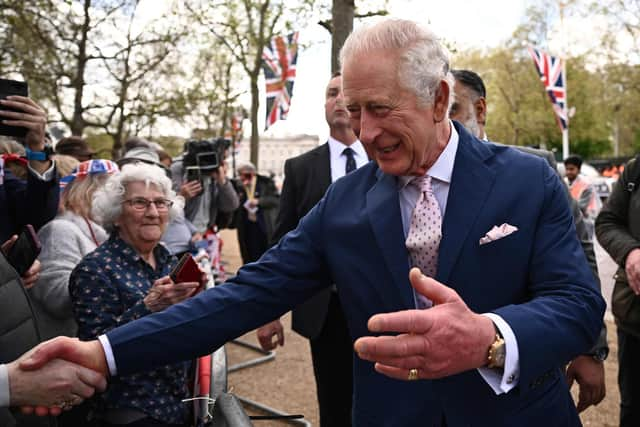Coronation King Charles III: Why monarchs do not need to be crowed in Scotland
Some aspects of the coronation of King Charles III today have been updated to reflect modern tastes – the oil with which the king will be anointed is to contain no animal products, for example – but it will still be a deeply traditional occasion, shaped by centuries of precedents.
From a Scottish perspective, the famous Stone of Destiny on which Scottish monarchs were crowned prior to 1296 has been relocated from Edinburgh to Westminster for the day, and yet the coronation will be an essentially Anglican service in continuity with English coronations preceding the creation of the United Kingdom in 1707.
Advertisement
Hide AdAdvertisement
Hide AdThe coronation’s ‘Englishness’ reflects the nature of the union of 1707 – the union tended to add Scots to pre-existing English institutions rather than creating new British structures. One result of this approach to uniting the kingdoms was the coronations of post-union monarchs – George I to Elizabeth II – retained Anglican ritual. The late queen’s regnal number (‘II’) is itself, evidence that monarchs have been regarded as the successors of England’s pre-union kings and queens, rather than representatives of a British institution founded in 1707.


There is a further reason why the coronations of the UK’s monarchs have been English in character. In the second half of the 17th century, the Scottish coronation ritual fell into disuse. The last monarch to receive a Scottish coronation was Charles II, who was crowned at Scone on January 1, 1651. While his successors James VII and II, William II and III and Anne were crowned in England, none visited Scotland after ascending the throne.
Had separate Scottish coronations been deemed necessary, they might have taken some years to arrange. After all, Charles I, the first monarch after James VI of Scotland succeeded to the English throne as James I, was crowned in Scotland eight years after becoming king. But few contemporaries were particularly concerned the final three pre-union monarchs were not crowned in Scotland.
How is the eclipse of the Scottish coronation to be explained? In the late 17th century, we might argue, the Scottish coronation oath was disentangled from the ritual of which it was traditionally part. The oath came to be seen as an indispensable promise by the new monarch to rule the kingdom according to its laws. The ceremony of coronation, on the other hand, could be quietly abandoned. Whereas coronation entailed a trip to Scotland, a new king or queen could swear the oath without leaving London.
This development occurred thanks to the controversial reign of James VII and II, Britain’s last Catholic monarch. Though James underwent an amended version of the Anglican ceremony shortly after becoming king in 1685, he was not crowned in Scotland, nor did he swear the Scottish coronation oath.
The oath required monarchs to uphold the Reformed religion, and James regarded such an undertaking as incompatible with his chief political priority – granting toleration to his Catholic subjects. When James was overthrown in the revolution of 1688-90, the supporters of revolution assembled in the Scottish convention of estates thought that the king’s failure to swear the coronation oath justified his removal from the throne. According to the convention, James’s refusal to promise he would govern lawfully enabled him to change Scotland from ‘a legally limited monarchy’ to an ‘arbitrary despotick power’.
Because the Catholic James had avoided the oath and abused his power, Scotland’s political elite ensured his protestant successors swore the oath. In 1689, William and Mary, victors of the revolution, were offered the Scottish throne – and required to take the coronation oath. After coming to the throne in 1702, one of Queen Anne’s first duties was to swear the Scottish coronation oath, tendered to her by members of the Scottish privy council then present in London. Not only had the oath been separated from the coronation ceremony, but it was administered immediately on the monarch’s accession to the throne. Swearing the oath became a precondition for monarchical authority over Scotland.
Those who watched the television coverage of King Charles III’s accession council in September may have noticed the new king also began his reign by swearing an oath relating to Scotland. This was a result of the Act for the Security of the Church of Scotland, adopted by the Scottish Parliament alongside the union in 1707. On their accession to the throne, this statute requires, British monarchs promise to uphold the presbyterian government of the Scottish Church as settled in 1690. The Act for the Security of the Church of Scotland created a new oath, taking the place of the old Scottish coronation oath. The new oath, like its predecessor, has been seen as an essential prerequisite for the exercise of royal power.
Advertisement
Hide AdAdvertisement
Hide AdIn the multi-faith, but largely secular Britain of 2023, many will regard the Anglican character of the king’s coronation, like his promise to preserve Scottish presbyterianism, as anachronistic. Both are legacies of the union of 1707. The political struggles of the late 17th and early 18th centuries did much to define the constitutional position – and ceremonial trappings – of the British monarchy today.
- Alasdair Raffe is a senior lecturer in history at the University of Edinburgh.
Comments
Want to join the conversation? Please or to comment on this article.